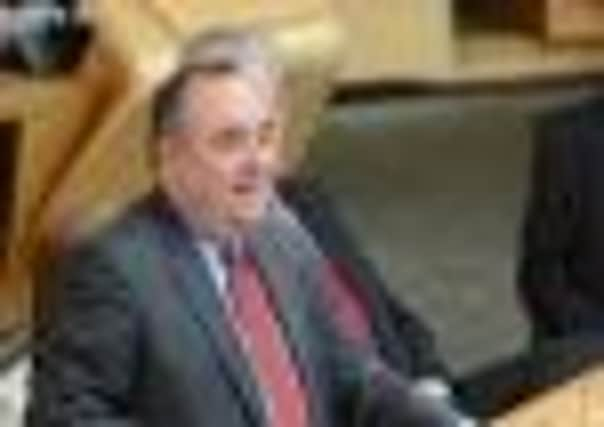Euan McColm: Unionist divisions threaten to play into Salmond’s hands


What emerged was a warning from the civil servant to colleagues that Chancellor George Osborne is planning a further £10 billion in welfare cuts next year. Sir Peter’s gloomy words soon created headlines. For those involved in the “Better Together” campaign against the break-up of the United Kingdom, the reports made particularly painful reading.
One of the greatest concerns of the unionist campaign is the impact that cuts, emanating from Westminster, will have as the referendum campaign builds momentum. Sir Peter’s words came as a reminder of the hard fight ahead. The impression just now – based on poll after poll – may be that the “Yes” campaign faces a mountain too high to climb. Fast forward a year, though, and we’ll be in completely different times.
Advertisement
Hide AdAdvertisement
Hide AdThe Institute for Fiscal Studies recently warned that we’ve seen only 12 per cent of the spending cuts planned (or inherited and supported) by the coalition. That’s a dizzying 88 per cent of the misery yet to come. And that’s a problem for the campaign against Scottish independence.
A year from now, far more Scots will have experienced the sharper end of government austerity measures. More people will face joblessness, home repossession, dwindling pensions… uncertainty. What an opportunity that will represent for the “Yes” campaign – and its inevitable figurehead, First Minister Alex Salmond. Unionists may feel the Nationalists lack momentum just now – and in terms of adding significant new voices or ideas – I’d tend to agree. There will be no shortage of momentum, however, if the Nationalists can create a “statesman” Salmond versus “Toryboy” Cameron campaign.
It’s a scenario some on the unionist campaign see as inevitable. The answer, for now, among “No” campaign optimists is that – even in those circumstances – it will be down to the SNP/Yes campaign to provide rock-solid details of how they might do things differently, how they might deal with an inherited share of the UK’s debt, and how they might better protect welfare and pensions.
Well, maybe. Finance Secretary John Swinney does have to find detailed answers to all of these things. He has to find arguments that reassure on doorsteps and stand up to real scrutiny in debate. He doesn’t, however, have to do it on an uneven playing field.
Time was when two of the most relentlessly problematic issues for the SNP were the economy and welfare. Now? Is a unionist message that we’re better as part of the UK economy as strong as it was? Will it hold any weight at all next year?
Similarly, is there a broader sense among Scots that the welfare state is protected under the current coalition government? The onus is as great on unionists as it is on nationalists to explain how they’ll deal with current financial difficulties and those yet to come. Add into the mix a reputation for financial competence won by the SNP government since 2007 and the unionists have less still to play with.
There has long been a belief among unionists (and many nationalists) that, in difficult times, voters prefer the safety of the status quo to radical change. That may have been the case when the status quo looked, well, bearable at least. But the status quo of 2013 and beyond is likely to bear little resemblance to the one we have now. The comparison will not be positive.
Already SNP spinners are making great mischief over joint appearances on the campaign trail by Labour and Tory politicians. Labour politicians can do little but squirm. Given that much of their campaigning in recent elections has involved turning up at photo-calls, shouting “Thatcher”, and then leaving, some might say they rather have that one coming.
Advertisement
Hide AdAdvertisement
Hide AdExpect the SNP to continue to use those taunts. “More Tory cuts,” they’ll chant. “Better together? Really?” they’ll ask. It won’t just be voters hearing the message. Members of the unionist campaign do make for an unlikely alliance. The opportunity exists for the “Yes” campaign to shake the weak foundations of the Labour/Tory relationship. It will be difficult – and possibly intolerable – for some Labour politicians to stand alongside Tories if the nationalists are promising to free Scotland of “Cameron’s cuts”, while the impact of those cuts plays painfully out.
At the moment, the “Yes” campaign can comfortably bind together the most fervent anti-nuclear campaigner and the most avowedly pro-Nato politician under the same banner. Nationalist strategists don’t believe the unionist alliance is so tightly bound. I’m inclined to agree.
There’s no doubt that, especially in the Labour/Tory direction, some real hatred exists among co-campaigners. Come next year, those same foes-turned-friends will also be operating in a pre-general election atmosphere, where necessity will demand that they disagree profoundly and frequently on any subject that arises.
Into this maelstrom of cuts and “No” campaign instability comes striding Salmond, whose strategy of casting himself First Minister for, rather than of, Scotland helps bring even non-SNP members on board. That’s the nationalist vision and the unionist fear.
Alex Salmond is still a long way from realising his dream of Scottish independence. But if unionists think they’ll have the nap hand for the duration of the campaign, boy, are they wrong.
Sir Peter Housden’s internal memo reveals the battleground on which the referendum will eventually be fought. And it’s planted with booby traps for the unionist campaign. «